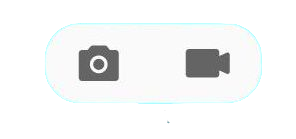Redirecting to a UIAbility Through the router Event
The router capability of the postCardAction API can be used in a widget to quickly start a specific UIAbility of the widget provider. By leveraging this capability, an application can provide in the widget multiple buttons, each of which targets a different target UIAbility. For example, a camera widget can provide the buttons that redirect the user to the UIAbility for taking a photo and the UIAbility for recording a video.

NOTE
This topic describes development for dynamic widgets. For static widgets, see FormLink.
Generally, a button is used to start a page. Below is an example:
-
Design two buttons on the widget page. When one of the buttons is clicked, postCardAction is called to send a router event to the specified UIAbility, with the content to be transferred defined in the event.
@Entry @Component struct WidgetEventRouterCard { build() { Column() { Text($r('app.string.JumpLabel')) .fontColor('#FFFFFF') .opacity(0.9) .fontSize(14) .margin({ top: '8%', left: '10%' }) Row() { Column() { Button() { Text($r('app.string.ButtonA_label')) .fontColor('#45A6F4') .fontSize(12) } .width(120) .height(32) .margin({ top: '20%' }) .backgroundColor('#FFFFFF') .borderRadius(16) .onClick(() => { postCardAction(this, { action: 'router', abilityName: 'EntryAbility', params: { targetPage: 'funA' } }); }) Button() { Text($r('app.string.ButtonB_label')) .fontColor('#45A6F4') .fontSize(12) } .width(120) .height(32) .margin({ top: '8%', bottom: '15vp' }) .backgroundColor('#FFFFFF') .borderRadius(16) .onClick(() => { postCardAction(this, { action: 'router', abilityName: 'EntryAbility', params: { targetPage: 'funB' } }); }) } }.width('100%').height('80%') .justifyContent(FlexAlign.Center) } .width('100%') .height('100%') .alignItems(HorizontalAlign.Start) .backgroundImage($r('app.media.CardEvent')) .backgroundImageSize(ImageSize.Cover) } } -
The UIAbility receives the router event and obtains parameters. It then starts the page specified by params.
import type AbilityConstant from '@ohos.app.ability.AbilityConstant'; import hilog from '@ohos.hilog'; import UIAbility from '@ohos.app.ability.UIAbility'; import type Want from '@ohos.app.ability.Want'; import type window from '@ohos.window'; const TAG: string = 'EntryAbility'; const DOMAIN_NUMBER: number = 0xFF00; export default class EntryAbility extends UIAbility { private selectPage: string = ''; private currentWindowStage: window.WindowStage | null = null; onCreate(want: Want, launchParam: AbilityConstant.LaunchParam): void { // Obtain the targetPage parameter passed in the router event. hilog.info(DOMAIN_NUMBER, TAG, `Ability onCreate, ${JSON.stringify(want)}`); if (want.parameters !== undefined) { let params: Record<string, string> = JSON.parse(JSON.stringify(want.parameters)); this.selectPage = params.targetPage; } } // If the UIAbility is running in the background, the onNewWant lifecycle callback is triggered after the router event is received. onNewWant(want: Want, launchParam: AbilityConstant.LaunchParam): void { hilog.info(DOMAIN_NUMBER, TAG, `onNewWant Want: ${JSON.stringify(want)}`); if (want.parameters?.params !== undefined) { let params: Record<string, string> = JSON.parse(JSON.stringify(want.parameters)); this.selectPage = params.targetPage; } if (this.currentWindowStage !== null) { this.onWindowStageCreate(this.currentWindowStage); } } onWindowStageCreate(windowStage: window.WindowStage): void { // Main window is created, set main page for this ability let targetPage: string; // Start the page specified by targetPage. switch (this.selectPage) { case 'funA': targetPage = 'pages/FunA'; break; case 'funB': targetPage = 'pages/FunB'; break; default: targetPage = 'pages/Index'; } if (this.currentWindowStage === null) { this.currentWindowStage = windowStage; } windowStage.loadContent(targetPage, (err, data) => { if (err.code) { hilog.error(DOMAIN_NUMBER, TAG, 'Failed to load the content. Cause: %{public}s', JSON.stringify(err) ?? ''); return; } hilog.info(DOMAIN_NUMBER, TAG, 'Succeeded in loading the content. Data: %{public}s', JSON.stringify(data) ?? ''); }); } }